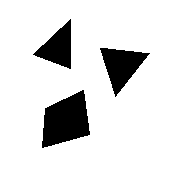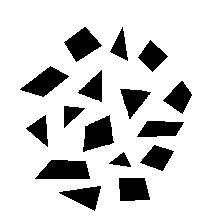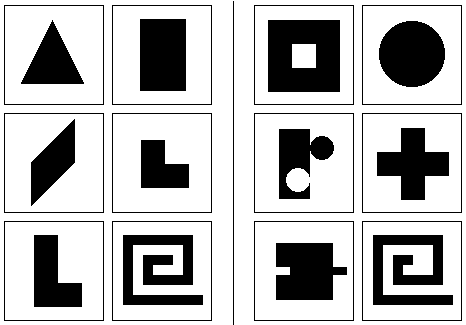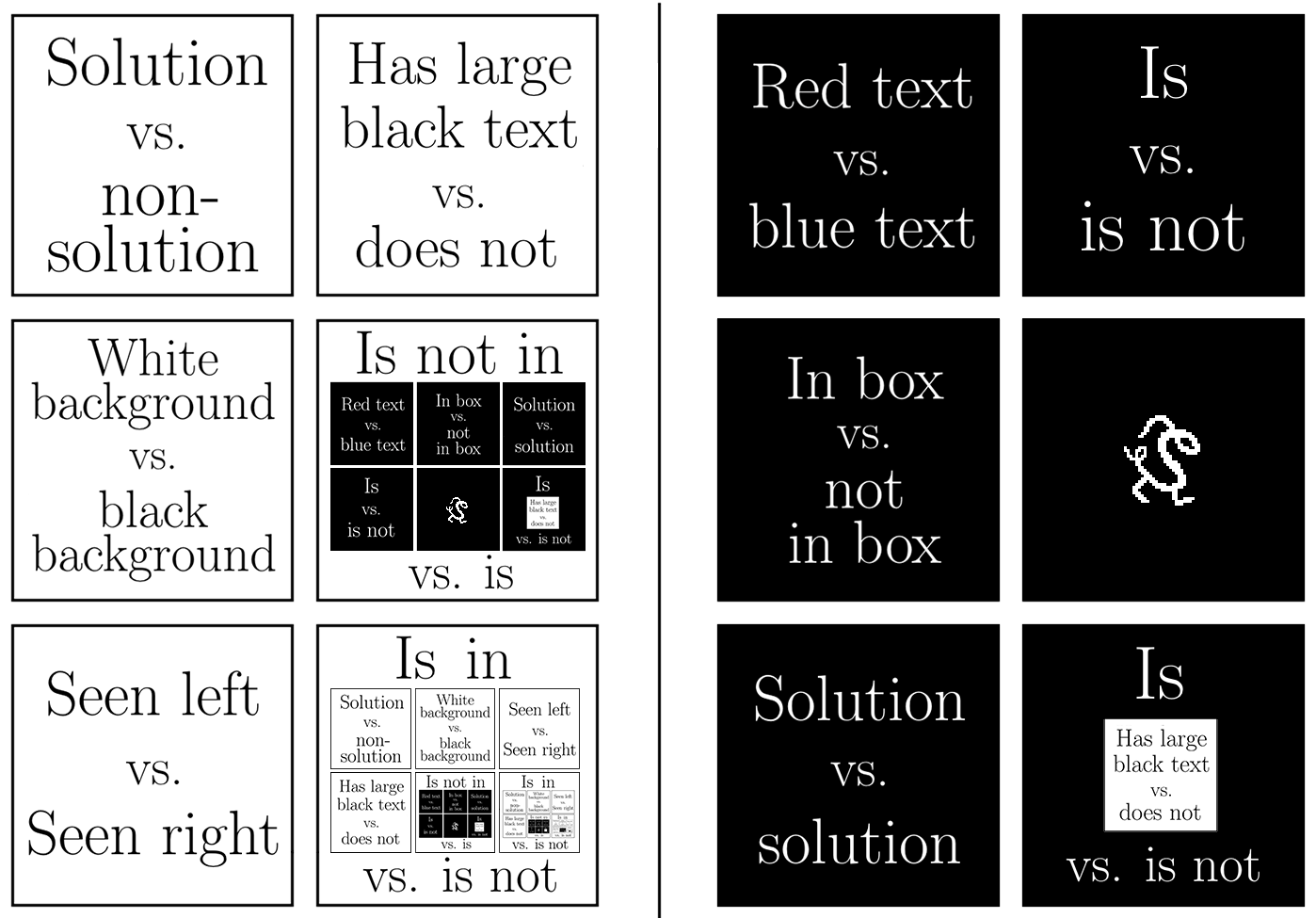Please enjoy the following collection of objects.

If you have recognized CIRCLES, congratulations!
A Bongard Problem traditionally includes
- a dividing line,
- six images on the left side of the dividing line, and
- six images on the right side of the dividing line.

Large versus small.
This is the solution of the Bongard Problem. Seeing the difference is solving the Problem.
BP000003

Outline vs. filled.

Outline vs. filled.
BP000004

Convex vs. concave.

Convex vs. concave.
The first 100 Bongard Problems were created and presented by Mikhail M. Bongard in 1967 as a general intelligence challenge for machines.
One way to communicate an idea without words is by giving many examples. More examples clarify the idea.

Pattern: Polygons?

Pattern: Convex quadrilaterals and triangles.
Bongard Problems are more powerful. With counter-examples, not as many examples need to be given. Counter-examples very quickly narrow down what the rule might be.

Pattern: Convex quadrilaterals and triangles.
That is a Bongard Problem for you: some examples and counter-examples for a rule.
It's possible for a person to figure out what Bongard Problems are when presented enough of them without instructions. (We have seen it happen.) In other words, this is a non-verbal way of communicating that communicates itself non-verbally.

Pattern: Bongard Problems.
The solution to a Bongard Problem can take a good deal of ingenuity to find.

Warning: This one is hard!
Solution:
Each shape on the left can be tiled by smaller copies of itself.
So they make for good puzzles. (If you are here for the puzzles, visit our Solve page.)
Here are some basic observations about Bongard Problems.
-
A Bongard Problem cannot have the same image on both sides.
(If the same thing were to appear on both sides, then there couldn't be a property that applies to all things on one side but not the other.)

No Solution!
-
A Bongard Problem can have more than one solution.

Solution:Filled vs. outline.
Solution:No corners vs. corners.
-
Every Bongard Problem has a bunch of thoughtless solutions automatically. For example:
-
Is either left square 1 or left square 2 or left square 3 or left square 4 or left square 5 or left square 6 VS. is NOT any of these.
-
Is NOT right square 1 or right square 2 or right square 3 or right square 4 or right square 5 or right square 6 VS. IS one of these.
-
Is on the left-hand side of this very Bongard Problem vs. is on the right-hand side of this very Bongard Problem.
BP000545

Solution:Solution (for this very Bongard Problem) vs. non-solution.
(We normally don't put words in Bongard Problems.)
The intended solution ought to be by far the conceptually simplest. The mark of a good Bongard Problem: when a person solves it, they know it.
Although none of us has has a precise definition for "conceptually simplest", people independently, repeatedly, and consistently converge on the same solutions for good Bongard Problems. (Even hard ones.) Please check this empirically. -
Is either left square 1 or left square 2 or left square 3 or left square 4 or left square 5 or left square 6 VS. is NOT any of these.
-
Every Bongard Problem has a bunch of thoughtless solutions automatically. For example:
Welcome to The On-Line Encyclopedia of Logical Predicates!
By the time you and your friends have made a couple hundred Bongard Problems, you will notice something: just as different people will independently come up with the same solution for a Bongard Problem, different people designing Bongard Problems will independently come up with the same ideas for Bongard Problems.
This is the motivation for the On-Line Encyclopedia of Bongard Problems. Following the example of The On-Line Encyclopedia of Integer Sequences®, we aim to collect and categorize timeless ideas.
A page on the OEBP is an interesting or simple idea for a Bongard Problem along with instructions for adding more examples to it.
If all examples in your Bongard Problem would fit the same way as they would in an existing page on the OEBP and vice versa, we consider it to be a duplicate. If you were to re-submit an exact repeat of an existing Bongard Problem like that, we might reject it and point you to the existing page. (Do feel encouraged to add your new examples to the existing page.)
However, we err on the side of redundancy. If two slightly different versions of the same idea are both interesting, we will include them both in the database. You can find many variations on similar ideas on the OEBP. For example, there is a page for the Bongard Problem idea "even number of shapes vs. odd number of shapes" (BP202) and there is also a page for "even number of dots vs. odd number of dots" (BP334). We are in the business of collecting interesting Bongard Problems; if somebody makes an oddly specific reframed version of an old idea that is interesting, we want to have a page for it. To keep organized, we make the pages of related Bongard Problems cross-reference one another with hyperlinks.
As mentioned above, traditional Bongard Problems feature collections of images. But why not look for patterns in things other than pictures? On the OEBP, a "Bongard Problem" is allowed to sort any media at all. For example, BP300 sorts animated GIFs.
We frequently make Bongard Problems that sort other Bongard Problems on the Encyclopedia. These Bongard Problems categorizing Bongard Problems are called Meta Bongard Problems (or MBPs).

Solution:
Qualitative solution versus quantitative solution.
Also, on the OEBP, a "Bongard Problem" has no limit on how many examples go on either side. Users can add more examples to an existing Bongard Problem on the OEBP (the same as how users can add more numbers to an existing sequence on the OEIS®).
At heart, a page in this encyclopedia documents a property (or two) that things might have. If you don't like "Bongard Problem" you can call it "logical predicate".